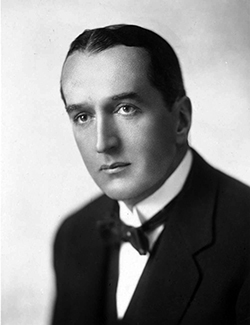Viscount Stanley M Bruce CH, MC, PC, FRS

Cambridge University Boat Club (UK)
15 April 1883 - 25th August 1967
Other than his school rowing, Stanley Bruce's rowing career was undertaken in the UK where he gained notoriety as an oarsman, coach and administrator. He is remembered primarily for his coaching at Cambridge University.
The family business was "Paterson, Laing and Bruce", importers of soft goods (clothing, fabrics and 'Manchester') from England. He was Chairman of it for many years. The business had a substantial warehouse in Flinders Lane in Melbourne and was a strong participant in Warehousemen's Cup rowing races, which boasted significant trophies, now on display at Mercantile Rowing Club. Whilst there is no direct evidence, no doubt Bruce would have been a strong supporter of this activity and quality rowing racing.
Stanley Bruce was a talented sportsman. An indication of this prowess was that he was captain of rowing, football and cricket in his final year at school. He was also school captain despite his academic record not being outstanding and Head of the Cadets. After his rowing career, he was an accomplished golfer and became the first Australian elected Captain of the Royal and Ancient Golf Club, St Andrews.
Whilst reading law at Trinity Hall, Cambridge, he raced in the victorious 1904 Boat Race crew. His academic record was again unspectacular and he admitted later that "I did nothing but row" in his first year.
In 1913, he coached the Thames Rowing Club in the Grand Challenge Cup. He later went onto coach Cambridge to a win in the last Boat Race prior to WWI in 1914. In 1919, Bruce was credited with making the Cambridge University eight a strong contender for the race for the King's Cup at the Henley Peace Regatta.
Dr Bruce Coe in his book of the King's Cup offered the following anecdote regarding Bruce presenting the King's Cup in 1928 whilst Prime Minister. When presenting the King's Cup to the victorious Western Australian crew after the 1928 championship race on Sydney's Nepean River, Australian Prime Minister Stanley Bruce thought it most appropriate to be handling the trophy. He told those watching that as coach of the Cambridge University crew at the Royal Henley Peace Regatta 'he had done all he could to prevent it coming to Australia.'
Bruce served with distinction in WWI in the British Army. He was awarded the Military Cross and the Croix de Guerre and rose to the rank of Captain. After being wounded with a gun shot wound to the knee, he was permitted to return to Australia to recuperate. His Wikipedia entry records: As a decorated soldier on crutches with a gift for public speaking, he was enlisted to become a spokesperson for government recruitment in Australia. His success and popularity in this role brought the attention of the Nationalist League and then Prime Minister Billy Hughes, who lobbied the British government on his behalf and succeeded in convincing the War Office to allow Bruce to relinquish his commission in June 1917. This then led to the commencement of his political career.
Bruce was also the first Australian to be elected a Steward of the Henley Royal Regatta and President of Leander Club.
And of course his greatest claim to fame was that he was later to become Australia’s eighth Prime Minister in 1923.
Rowing record highlights
1900 - APS Head of the River, three seat - Third
1901 - APS Head of the River, six seat - Fourth
1904 - The Boat Race, Cambridge, two seat - First
1913 - Henley Royal Regatta, Grand Challenge Cup, Thames Rowing Club, coach - Unplaced
1914 - The Boat Race, Cambridge, coach - First
1919 - Henley Peace Regatta, Cambridge, coach
Andrew Guerin
June 2021 (updated 2023)
Sources:
- Pulling Through - The story of the King's Cup by Bruce Coe published by Andrew Guerin 2019
- Stanley Bruce - Wikipedia extracted 17 Nov 2023
- Stanley Melbourne Bruce: In Australia's Service by Dyson Heydon, Quadrant magazine Nov 2023, Vol LXVII, Number 11

